Experimental Investigations of a Solar Water Treatment System for Remote Desert Areas of Pakistan
Abstract
:1. Introduction
Pakistan’s Water Situation
2. Climatology and Solar Potential
3. Proposed System and Methodology
4. Governing Equations
5. Results and Discussion
6. Conclusions
Author Contributions
Funding
Institutional Review Board Statement
Informed Consent Statement
Data Availability Statement
Acknowledgments
Conflicts of Interest
Nomenclature
| cp | specific heat, kJ/kg·K |
| Fs | shape factor |
| G | solar irradiations, W/m2 |
| hc | heat transfer coefficient convection, W/m2·K |
| hfg | enthalpy of evaporation, J/kg |
| hga | heat transfer coefficient convection from glass to air, W/m2·K |
| hw | heat transfer coefficient for water, W/m2·K |
| L | length of basin, m |
| k | thermal conductivity, W/m·K |
| mass of distillate, kg | |
| Mdryair | molar mass of dry air |
| Mw,vapour | molar mass of water vapors |
| Nusselt number | |
| Pambient | the partial pressure at ambient temperature, mm Hg |
| Pr | Prandtl number |
| Pw | the partial pressure at basin water temperature, mm Hg |
| Pwg | the partial pressure at a glass temperature, mm Hg |
| qba | heat loss from basin to air, W/m2 |
| qga | heat loss from glass to air, W/m2 |
| qr | heat loss through radiations, W/m2 |
| qc | heat loss through convection, W/m2 |
| qe | heat loss through evaporation, W/m2 |
| Ra | Raleigh number |
| Re | Reynold number |
| Ta | temperature of air, °C |
| Tb | temperature of basin, °C |
| Tg | temperature of glass, °C |
| Tw | temperature of feed water, °C |
| Ub | overall heat transfer through a basin, W/m2·K |
| Vwind | wind velocity, km/h |
| Greek letter | |
| absorptivity | |
| absorptivity of water | |
| inclination angle | |
| emissivity of glass | |
| Stiffen–Boltzmann constant | |
| transmittivity of glass | |
| kinematic viscosity | |
| Subscripts | |
| b | basin |
| g | glass |
| w | water |
| Abbreviations | |
| AD | Adsorption |
| AEDB | Alternative energy development board |
| GDP | Gross domestic product |
| GHI | Global horizontal irradiance, kWh/m2/d |
| IWRM | Integrated water resource management |
| MED | Multi effect desalination |
| mha | Million hectares |
| MSF | Multistage flash |
| NCBI | National Capacity Building Institute |
| PCRWR | Pakistan council of research in water resources |
| ppm | Parts per million |
| SWRO | Seawater reverse osmosis |
| TDS | Total dissolved solids |
| UNDP | United nations development program |
| UNICEF | United nations international children’s emergency fund |
| WHO | World health organization |
Appendix A
| Agenda Items | Suggested Action |
|---|---|
| Conservation and efficiency | Water wastage should be reduced, and water conservation and supply efficiency must be emphasized. |
| Storage capacity | The building of medium and small capacity dams, enhancing the life of existing storage mediums and construction of Reni Canal and Kachi Canal |
| Leveraging technologies | Seawater utilization, water recycling, preparation of an inventory of water resources through remote sensing and precise monitoring of irrigation water distribution. |
| Renewable energy | Small, medium, and large-scale hydropower projects and solar-based seawater desalination systems. |
| Integrated water resource management (IWRM) | IWRM should be adopted on all up-and-down streams to minimize water mining and contamination. |
| Comprehensive regulatory management | Food, water, and energy safety, effective and sustainable water usage, and proper wastewater management. |
| Planning principles | Access to safe drinking water, environmental sustainability, innovation, and feasibility of new projects. |
| Department | Main Points |
|---|---|
| Ministry of Planning and Development (2018) |
|
| Ministry of Environment (2005) |
|
| Supreme Court of Pakistan (2018) [68] |
|
| Organization | Sector Type | Focused Areas |
|---|---|---|
| UNICEF Pakistan (1948) | NGO | Clean water, sanitation, health and nutrition |
| WHO-Pakistan (1948) | NGO | Water, sanitation, and world health |
| Pakistan Council of Research in Water Resources (PCRWR) (1964) | Government | Water quality, water management, rainwater harvesting, and desertification control |
| Centre of Excellence in Water Resources Engineering, UET Lahore, (1976) | Government | Water resource management and hydropower |
| Pakistan Desalination Association (1994) | NGO | Desalination |
| U.S-Pakistan Centers for Advanced Studies in Water, Mehran University Jamshoro (2014) | USAID | Water scarcity, water quality, ecosystem and performance of water utilities |
| Punjab Saaf Pani Company (2014) | Government | Safe drinking water |
| Center for Water informatics and Technology (WIT), LUMS, Lahore (2016) | Private | Hydro-informatics and systems analysis |
| National Capacity Building Institute (NCBI), Collaborated with PCRWR (2017) | Government | Climate extremes, water quality, and water management |
| Plant Type | Location and Design Capacity | Inauguration Date and Status | Sponsors |
|---|---|---|---|
| Thermal-based system (Multi-Effect Desalination system (MED) | Defense Housing Authority (DHA), Phase-8, Karachi, (11,355 m3/day) | Inaugurated in April 2008, Not operational | DHA Cogen Limited |
| Thermal-based systems (Rs 200 Million for each) | Pasni, Jewani, and Singhar (Baluchistan) (757 m3/day) | Approved in 2008 Installed but not operational | Baluchistan Development Authority |
| Thermal-based (Rs. 01 Billion) | Gwadar City (7570 m3/day) | Approved in 2008, Partially started in 2014 (with 1135 m3/day) Partially operational | Baluchistan Development Authority |
| Thermal-based system | Gwadar Port (960 m3/day) | Inaugurated Jan 2018 Operational | China Overseas Port Holding Company |
| Thermal-based | Gwadar City 16,600 m3/day | Construction started in March 2018Under construction | UAE/ Switzerland |
| Thermal-Nuclear based cogeneration plant (MED) | KENUPP 4800 m3/day | Commissioned in 2012, Partially started in 2014 (with 1600 m3/day) Partially operational | Government of Pakistan |
References
- UNESCO, United Nations World Water Development Report, 2019: Leaving No One Behind, UNESCO Publishing, 2019. Available online: https://en.unesco.org/themes/water-security/wwap/wwdr/2019 (accessed on 4 October 2020).
- Ghofrani, I.; Moosavi, A. Energy, exergy, exergoeconomics, and exergoenvironmental assessment of three brine recycle humidification-dehumidification desalination systems applicable for industrial wastewater treatment. Energy Convers. Manag. 2020, 205, 112349. [Google Scholar] [CrossRef]
- Shahzad, M.W.; Burhan, M.; Ghaffour, N.; Ng, K.C. A multi evaporator desalination system operated with thermocline energy for future sustainability. Desalination 2018, 435, 268–277. [Google Scholar] [CrossRef]
- Immerzeel, W.; Droogers, P.; Terink, W.; Hoogeveen, J. Middle-East and Northern Africa Water Outlook. Rep. Future Water 2011, 31, 1–135. [Google Scholar]
- Parris, A.; Bromirski, P.; Burkett, V.; Cayan, D.; Culver, M.; Hall, J.; Horton, R.; Knuuti, K.; Moss, R.; Obeysekera, J.; et al. Global Sea Level Rise Scenarios for the United States National Climate Assessment. NOAA TR OAR CPO 2016. 1–33. Available online: https://scenarios.globalchange.gov/sites/default/files/NOAA_SLR_r3_0.pdf (accessed on 4 October 2020).
- Ghaffour, N. The challenge of capacity-building strategies and perspectives for desalination for sustainable water use in MENA. Desalination Water Treat. 2009, 5, 48–53. [Google Scholar] [CrossRef]
- Shahzad, M.W.; Burhan, M.; Ybyraiymkul, D.; Ng, K.C. Desalination Processes’ Efficiency and Future Roadmap. Entropy 2019, 21, 84. [Google Scholar] [CrossRef] [Green Version]
- Jamil, M.A.; Zubair, S.M. Design and analysis of a forward feed multi-effect mechanical vapor compression desalination system: An exergo-economic approach. Energy 2017, 140, 1107–1120. [Google Scholar] [CrossRef]
- Jamil, M.A.; Zubair, S.M. On thermoeconomic analysis of a single-effect mechanical vapor compression desalination system. Desalination 2017, 420, 292–307. [Google Scholar] [CrossRef]
- Jamil, M.A.; Qureshi, B.A.; Zubair, S.M. Exergo-economic analysis of a seawater reverse osmosis desalination plant with various retrofit options. Desalination 2017, 401, 88–98. [Google Scholar] [CrossRef]
- Son, H.S.; Shahzad, M.W.; Ghaffour, N.; Ng, K.C. Pilot studies on synergetic impacts of energy utilization in hybrid desalination system: Multi-effect distillation and adsorption cycle (MED-AD). Desalination 2020, 477, 114266. [Google Scholar] [CrossRef]
- Ng, K.C.; Thu, K.; Oh, S.J.; Ang, L.; Shahzad, M.W.; Bin Ismail, A. Recent developments in thermally-driven seawater desalination: Energy efficiency improvement by hybridization of the MED and AD cycles. Desalination 2015, 356, 255–270. [Google Scholar] [CrossRef]
- Abid, A.; Jamil, M.A.; Sabah, N.U.; Farooq, M.U.; Yaqoob, H.; Khan, L.A.; Shahzad, M.W. Exergoeconomic optimization of a forward feed multi-effect desalination system with and without energy recovery. Desalination 2021, 499, 114808. [Google Scholar] [CrossRef]
- Chen, Q.; Alrowais, R.; Burhan, M.; Ybyraiymkul, D.; Shahzad, M.W.; Li, Y.; Ng, K.C. A self-sustainable solar desalination system using direct spray technology. Energy 2020, 205, 118037. [Google Scholar] [CrossRef]
- Alrowais, R.; Qian, C.; Burhan, M.; Ybyraiymkul, D.; Shahzad, M.W.; Ng, K.C. A greener seawater desalination method by direct-contact spray evaporation and condensation (DCSEC): Experiments. Appl. Therm. Eng. 2020, 179, 115629. [Google Scholar] [CrossRef]
- Jamil, M.A.; Shahzad, M.W.; Zubair, S.M. A comprehensive framework for thermoeconomic analysis of desalination systems. Energy Convers. Manag. 2020, 222, 113188. [Google Scholar] [CrossRef] [PubMed]
- The Worl Bank, Nearly Half the World Lives on Less Than $ 5.50 a Day. 2018. Available online: https://www.worldbank.org/en/news/press-release/2018/10/17/nearly-half-the-world-lives-on-less-than-550-a-day (accessed on 13 June 2020).
- AL-Jazeera, Pakistan Daily Wagers Struggle to Survive in Coronavirus Lockdown. 2020. Available online: https://www.aljazeera.com/news/2020/03/pakistan-daily-wagers-struggle-survive-coronavirus-lockdown-200325115143152.html (accessed on 13 August 2020).
- WHO. Coronavirus Disease (COVID-19) Advice for the Public. 2020. Available online: https://www.who.int/emergencies/diseases/novel-coronavirus-2019/advice-for-public (accessed on 9 January 2021).
- Juela Quintuña, D.M. Estimated Impact of COVID-19 on Water Needs and Volume and Quality of Wastewater. SSRN Electron. J. 2020, 3, 1–18. [Google Scholar] [CrossRef]
- Ghaffour, N.; Missimer, T.M.; Amy, G.L. Technical review and evaluation of the economics of water desalination: Current and future challenges for better water supply sustainability. Desalination 2013, 309, 197–207. [Google Scholar] [CrossRef] [Green Version]
- Kalbusch, A.; Henning, E.; Brikalski, M.P.; de Luca, F.V.; Konrath, A.C. Impact of coronavirus (COVID-19) spread-prevention actions on urban water consumption. Resour. Conserv. Recycl. 2020, 163, 105098. [Google Scholar] [CrossRef]
- Li, C.; Goswami, Y.; Stefanakos, E. Solar assisted sea water desalination: A review. Renew. Sustain. Energy Rev. 2013, 19, 136–163. [Google Scholar] [CrossRef]
- PBS, Pakistan Bureau of Statistics, Census 2017. 2017. Available online: http://www.pbs.gov.pk/content/population-census (accessed on 18 February 2019).
- n-Calculators, Geometric Population Growth Calculator, Exponential Popul. Proj. Formula Calc. 2018. Available online: https://ncalculators.com/environmental/exponential-population-projection-calculator.htm (accessed on 8 November 2020).
- UN Water. The United Nations World Water Development Report 4; UN: Paris, France, 2012; Volume 2, Available online: https://www.unwater.org/publications/managing-water-uncertainty-risk/ (accessed on 8 November 2020).
- Luo, T.; Young, R.; Reig, P. Aqueduct Projected Water Stress Country Rankings. World Resources Institute: Washington, DC, USA, 2015. Available online: https://www.wri.org/resources/data-sets/aqueduct-projected-water-stress-country-rankings (accessed on 14 August 2020).
- PCRWR. Pakistan Council of Research in Waster Resources. 2018. Available online: http://pcrwr.gov.pk/water-quality/ (accessed on 8 November 2020).
- Finance Division. Governmen of Pakistan, Pakistan Economic Survey, Pakistan 2019–20. 2020. Available online: http://www.finance.gov.pk/survey_1920.html (accessed on 8 November 2020).
- PDA. Pakistan Development Advocate. Water Security in Pakistan: Issues and Challenges; Pakistan. 2016. Available online: https://www.pk.undp.org/content/pakistan/en/home/library/development_policy/development-advocate-pakistan--volume-3--issue-4.html (accessed on 8 November 2020).
- Rehman, A.; Jingdong, L.; Shahzad, B.; Chandio, A.A.; Hussain, I.; Nabi, G.; Iqbal, M.S. Economic perspectives of major field crops of Pakistan: An empirical study. Pac. Sci. Rev. B Humanit. Soc. Sci. 2015, 1, 145–158. [Google Scholar] [CrossRef] [Green Version]
- Nabeela, F.; Azizullah, A.; Bibi, R.; Uzma, S.; Murad, W.; Shakir, S.K.; Ullah, W.; Qasim, M.; Häder, D.-P. Microbial contamination of drinking water in Pakistan—A review. Environ. Sci. Pollut. Res. 2014, 21, 13929–13942. [Google Scholar] [CrossRef]
- Ahmad, S. Land and Water Resources of Pakistan—A Critical Assessment. Pak. Dev. Rev. 2007, 46, 911–937. [Google Scholar] [CrossRef] [Green Version]
- Jain, M. Status of Household Water Treatment and Safe Storage in 45 Countries and a Case Study in Northern India. Ph.D. Thesis, Massachusetts Institute of Technology, Cambridge, MA, USA, 2010. Available online: https://dspace.mit.edu/handle/1721.1/58082 (accessed on 8 November 2020).
- WHO. Guidelines for Drinking Water Quality; World Health Organization: Geneva, Switzerland, 1996; Volume 2. [Google Scholar]
- Daud, M.K.; Nafees, M.; Ali, S.; Rizwan, M.; Bajwa, R.A.; Shakoor, M.B.; Arshad, M.U.; Chatha, S.A.S.; Deeba, F.; Murad, W.; et al. Drinking Water Quality Status and Contamination in Pakistan. BioMed Res. Int. 2017, 2017, 1–18. [Google Scholar] [CrossRef] [PubMed]
- Malik, A.H.; Khan, Z.M.; Mahmood, Q.; Nasreen, S.; Bhatti, Z.A. Perspectives of low cost arsenic remediation of drinking water in Pakistan and other countries. J. Hazard. Mater. 2009, 168, 1–12. [Google Scholar] [CrossRef]
- Shahid, M.; Niazi, N.K.; Dumat, C.; Naidu, R.; Khalid, S.; Rahman, M.M.; Bibi, I. A meta-analysis of the distribution, sources and health risks of arsenic-contaminated groundwater in Pakistan. Environ. Pollut. 2018, 242, 307–319. [Google Scholar] [CrossRef]
- Luby, S.; Agboatwalla, M.; Raza, A.; Sobel, J.; Mintz, E.; Baier, K.; Rahbar, M.; Qureshi, S.; Hassan, R.; Ghouri, F.; et al. A low-cost intervention for cleaner drinking water in Karachi, Pakistan. Int. J. Infect. Dis. 2001, 5, 144–150. [Google Scholar] [CrossRef] [Green Version]
- Azizullah, A.; Khattak, M.N.K.; Richter, P.; Häder, D.-P. Water pollution in Pakistan and its impact on public health—A review. Environ. Int. 2011, 37, 479–497. [Google Scholar] [CrossRef]
- UNICEF Pakistan, Pakistan Annual Report 2016. 2016. Available online: http://www.unicef.org/pakistan/FINAL_UNICEF_Annual_Report_2013_-_Version_11.1.pdf (accessed on 10 December 2020).
- Gulab, S.A. Waterborne diseases, Pakistan Obs. 2016. Available online: https://pakobserver.net/waterborne-diseases-2/ (accessed on 31 July 2020).
- WHO, World Health Organization, Pakistan, WHO. 2018. Available online: http://www.who.int/countries/pak/en/ (accessed on 31 July 2020).
- UNESCO. 2018–2028 International Decade for Action, ‘Water for Sustainable Development’, UNESCO. 2018. Available online: http://www.unesco.org/new/en/brasilia/about-this-office/prizes-and-celebrations/2018-2028-international-decade-for-action-water-for-sustainable-development/ (accessed on 27 August 2020).
- Kiani, K. Pakistan to Adopt UN Decade of Action for Water Sector, DAWN. 2018. Available online: https://www.dawn.com/news/1415084/pakistan-to-adopt-un-decade-of-action-for-water-sector (accessed on 27 August 2020).
- Ministry of Water Resouces. National Water Policy, 2018; Pakistan. 2018. Available online: https://www.thethirdpole.net/en/climate/pakistan-national-water-policy/?gclid=Cj0KCQjwmcWDBhCOARIsALgJ2QdCh7jC_wQ4A6eNb-_wb1s_KzTPi6y1q1ezmxu7QUq68hBSQj_hcy8aAuxYEALw_wcB (accessed on 27 August 2020).
- Pakistan Council of Research in Water Resources (PCRWR). PCRWR Annual Report 2013–14; Pakistan. 2015. Available online: www.pcrwr.gov.pk (accessed on 27 August 2020).
- Pakistan Bureau of Statistics, Housing Units by Source of Drinking Water, Lightening and Cooking Fuel. Pakistan Bur. Stat. 2020, 1. Available online: http://www.pbs.gov.pk/content/housing-units-source (accessed on 4 January 2021).
- Alternative Energy Development Board. Current Status of Solar PV Power Projects; Alternative Energy Development Board: Islamabad, Pakistan, 2020; Available online: https://www.aedb.org/ae-technologies/solar-power/solar-current-status (accessed on 27 August 2020).
- Jamaly, S.; Darwish, N.; Ahmed, I.; Hasan, S.W. A short review on reverse osmosis pretreatment technologies. Desalination 2014, 354, 30–38. [Google Scholar] [CrossRef]
- Mehmood, K. Quotation for Domestic Reverse Osmosis System, Safe Water Technology, Canal Road, Rahim Yar Khan; Pakitan. 2020. Available online: https://goo.gl/maps/TDuxZtLkVKScQRzD8 (accessed on 4 January 2021).
- Antar, M.A.; Zubair, S.M. Performance evaluation of a solar still in the Eastern Province of Saudi Arabia—An improved analysis. Desalination Water Treat. 2010, 22, 100–110. [Google Scholar] [CrossRef]
- Zhang, L.; Xu, Z.; Bhatia, B.; Li, B.; Zhao, L.; Wang, E.N. Modeling and performance analysis of high-efficiency thermally-localized multistage solar stills. Appl. Energy 2020, 266, 114864. [Google Scholar] [CrossRef]
- Chamsa-Ard, W.; Fawcett, D.; Fung, C.C.; Poinern, G. Solar Thermal Energy Stills for Desalination: A Review of Designs, Operational Parameters and Material Advances. J. Energy Power Technol. 2020, 2. [Google Scholar] [CrossRef]
- NASA, RETScreen Software, NASA Agency. 2020. Available online: https://www.nasa.gov/ (accessed on 15 December 2020).
- Boukar, M.; Harmim, A. Effect of climatic conditions on the performance of a simple basin solar still: A comparative study. Desalination 2001, 137, 15–22. [Google Scholar] [CrossRef]
- Muftah, A.F.; Alghoul, M.; Fudholi, A.; Abdul-Majeed, M.; Sopian, K. Factors affecting basin type solar still productivity: A detailed review. Renew. Sustain. Energy Rev. 2014, 32, 430–447. [Google Scholar] [CrossRef]
- Aburideh, H.; Deliou, A.; Abbad, B.; Alaoui, F.; Tassalit, D.; Tigrine, Z. An Experimental Study of a Solar Still: Application on the sea water desalination of Fouka. Procedia Eng. 2012, 33, 475–484. [Google Scholar] [CrossRef] [Green Version]
- Al-Hinai, H.; Al-Nassri, M.; Jubran, B. Effect of climatic, design and operational parameters on the yield of a simple solar still. Energy Convers. Manag. 2002, 43, 1639–1650. [Google Scholar] [CrossRef]
- El-Sebaii, A. Effect of wind speed on active and passive solar stills. Energy Convers. Manag. 2004, 45, 1187–1204. [Google Scholar] [CrossRef]
- Lienhard, J.; Antar, M.A.; Bilton, A.; Blanco, J.; Zaragoza, G. Solar desalination. Annu. Rev. Heat Transf. 2012, 15, 277–347. [Google Scholar] [CrossRef]
- Jamil, M.A.; Goraya, T.S.; Ng, K.C.; Zubair, S.M.; Bin, B.; Shahzad, M.W. Optimizing the Energy Recovery Section in Thermal Desalination Systems for Improved Thermodynamic, Economic, and Environmental Performance. Int. Commun. Heat Mass Transf. 2021, 124, 105244. [Google Scholar] [CrossRef]
- Sparrow, E.M.; Ramsey, J.W.; Mass, E. Effect of Finite Width on Heat Transfer and Fluid Flow about an Inclined Rectangular Plate. J. Heat Transf. 1979, 101, 199–204. [Google Scholar] [CrossRef]
- MOWRP. Ministry of Water Reources, National Water Policy, Government of Pakistan. 2018. Available online: https://mowr.gov.pk/index.php/national-water-policy-2018/ (accessed on 10 December 2020).
- Reporter, Govt Planning to Solve Water, Energy Problem Permanently, NEWS. 2018. Available online: https://nation.com.pk/25-Aug-2018/govt-planning-to-solve-water-energy-problem-permanently-minister (accessed on 6 December 2020).
- Desk, W. Desalination of Seawater Proposed to Tackle Pakistan’s Looming Water Crisis, NEWS. 2018. Available online: https://www.thenews.com.pk/latest/331972-desalination-of-seawater-proposed-to-tackle-pakistans-looming-water-crisis (accessed on 27 October 2020).
- Ministry of Energy, Government of Pakistan. National Environmental Policy 2005; Pakistan 2005. Available online: https://mowr.gov.pk/wp-content/uploads/2018/05/National-Environmental-Policy-2005.pdf (accessed on 27 October 2020).
- Kamboyo, S.H. Water Stress Matter, Supreme Court Pakistan. 2018. Available online: http://www.supremecourt.gov.pk/web/page.asp?id=230 (accessed on 10 January 2019).
- UNICEF. UNICEF Pakistan; Pakistan. 2018. Available online: https://www.unicef.org/pakistan/reports/unicef-pakistan-annual-report-2018 (accessed on 27 October 2020).
- PCRWR. Pakistan Council of Research in Water Resources; Pakisan. 2017. Available online: http://pcrwr.gov.pk/water-quality/ (accessed on 27 October 2020).
- CEWRE. Centre of Excellence in Water Resources Engineering; University of Technology: Lahore, Pakistan, 2012. [Google Scholar]
- Mubeen, F.M. Pakistan Desalination Association; Pakistan. 2018. Available online: https://elementalwaterfoundation.com/fight-water-crisis-donate-now/?gclid=Cj0KCQjwmcWDBhCOARIsALgJ2Qfkt2Jeac3hhFjsKnnbkQosn8ylcNA4H0UgswQw_9K9zFMAwBhNdFYaAq51EALw_wcB (accessed on 27 October 2020).
- USPCAS-W. U.S-Pakistan Centers for Advanced Studies in Water; Mehran University Technology: Jamshoro, Pakistan, 2018. [Google Scholar]
- Muhammad, D.A. Centre for Water Informatics and Technology (WIT); D.H.A, Lahore Cantt, Lahore, Pakistan. 2018. Available online: https://wit.lums.edu.pk/ (accessed on 27 October 2020).
- NCBI. National Capacity Building Institute: Lahore, Pakistan, 2018. Available online: https://www.pakistanpoint.com/en/story/204498/national-capacity-building-institute-inaugurated-at-pcr.html (accessed on 27 October 2020).
- PCRWR, Punjab Saaf Pani Company, Government of Pakistan, 2019. Available online: https://www.saafpani.org.pk/about-saaf-pani/introduction/ (accessed on 8 June 2019).
- International Nuclear Desalination Advisory Group, Indag Newsletter, 3; Paistan. 2004. Available online: https://www-pub.iaea.org/MTCD/Publications/PDF/Newsletters/INDAG-NL-3.pdf (accessed on 8 June 2019).
- DHA Cogen, MED Desalination Plant. 2018. Available online: http://dhacogen.com/ (accessed on 30 April 2020).
- Zafar, M. Desalination Plant Opens at Gwadar Port, Express Trib. 2018. Available online: https://tribune.com.pk/story/1598397/1-desalination-plant-opens-gwadar-port/ (accessed on 30 December 2020).
- Baloch, B. Four Desalination Plants Lying Idle in Gwadar Amid Water Shortage, DAWN. 2017. Available online: https://www.dawn.com/news/1310204 (accessed on 10 December 2020).
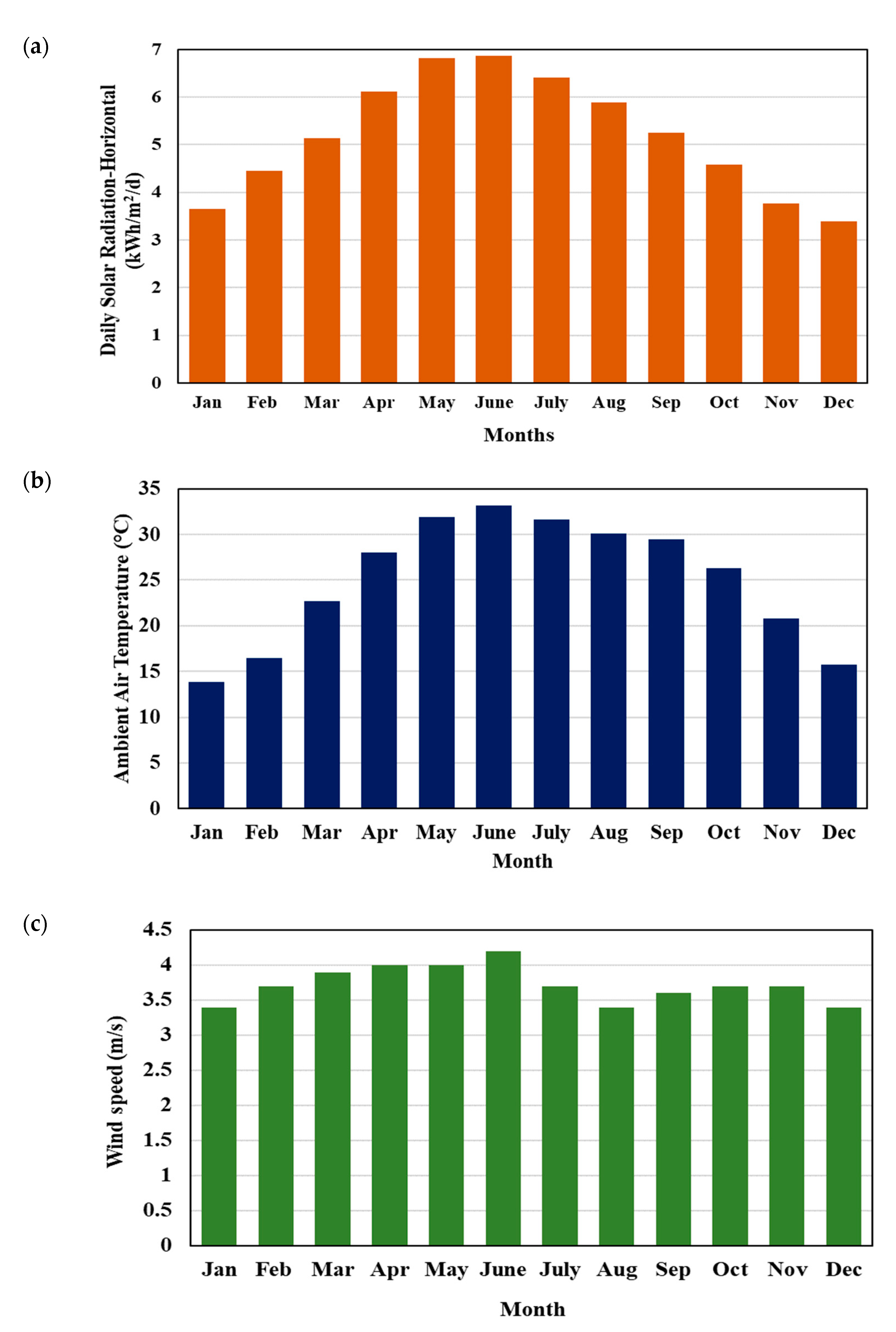
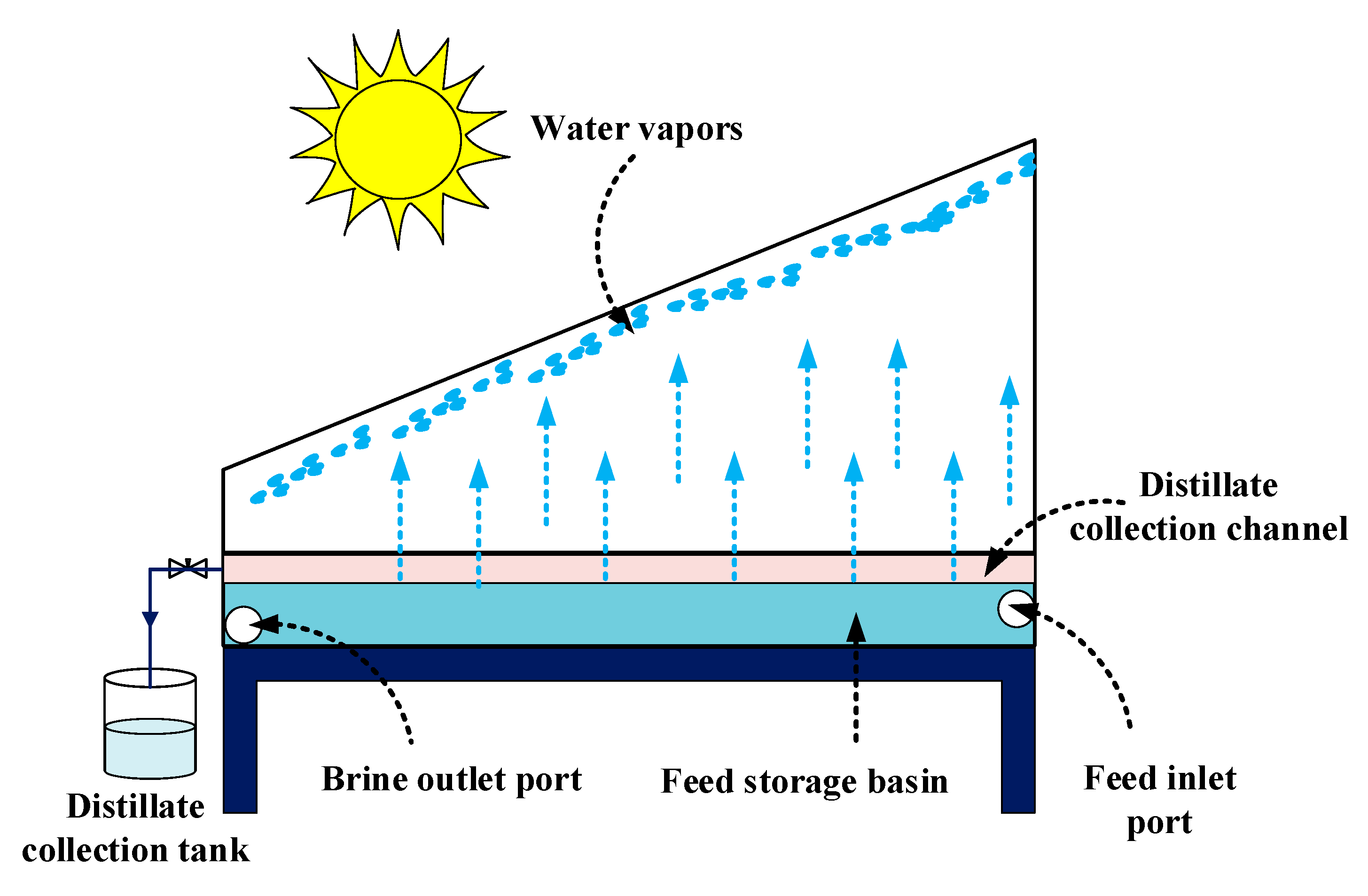
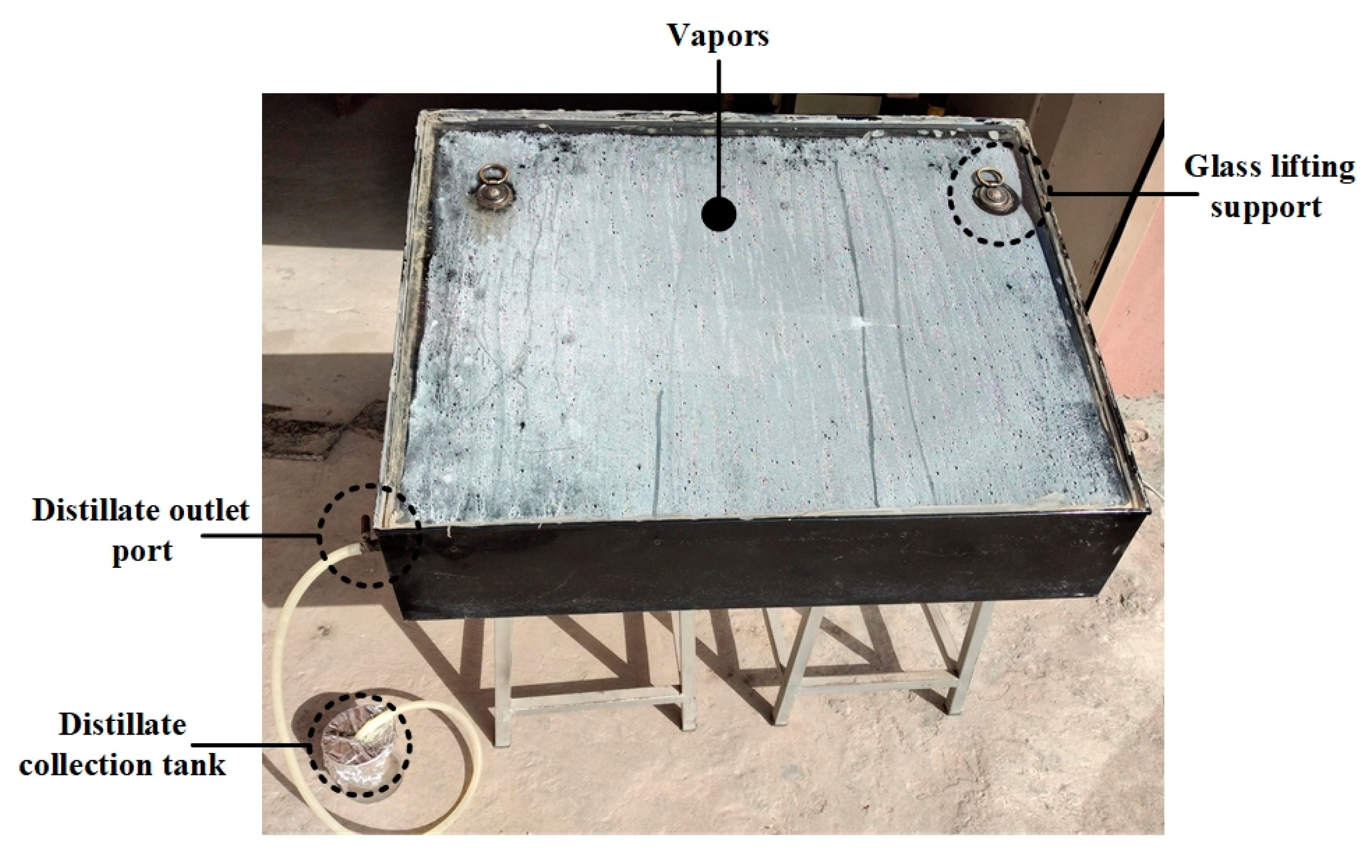
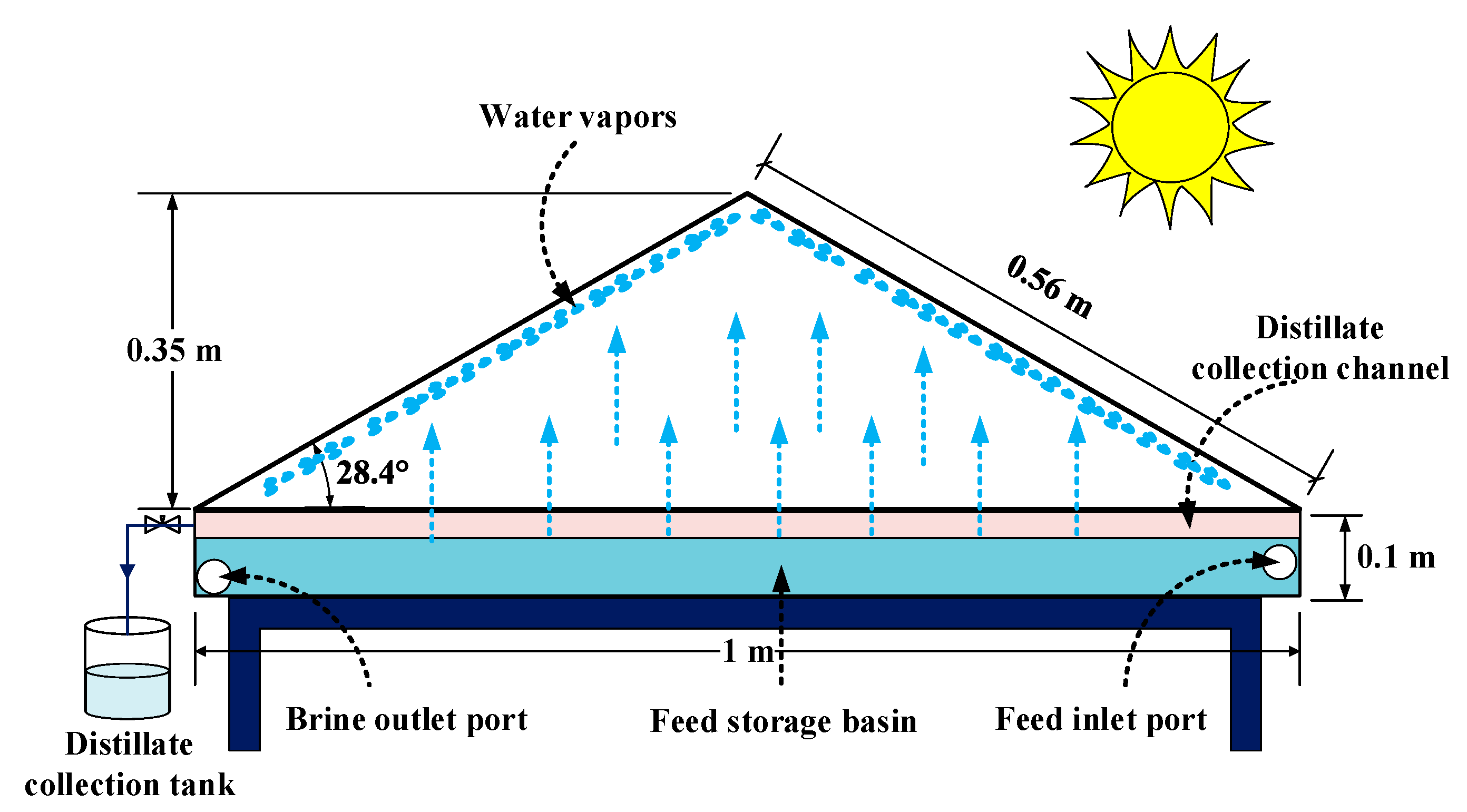
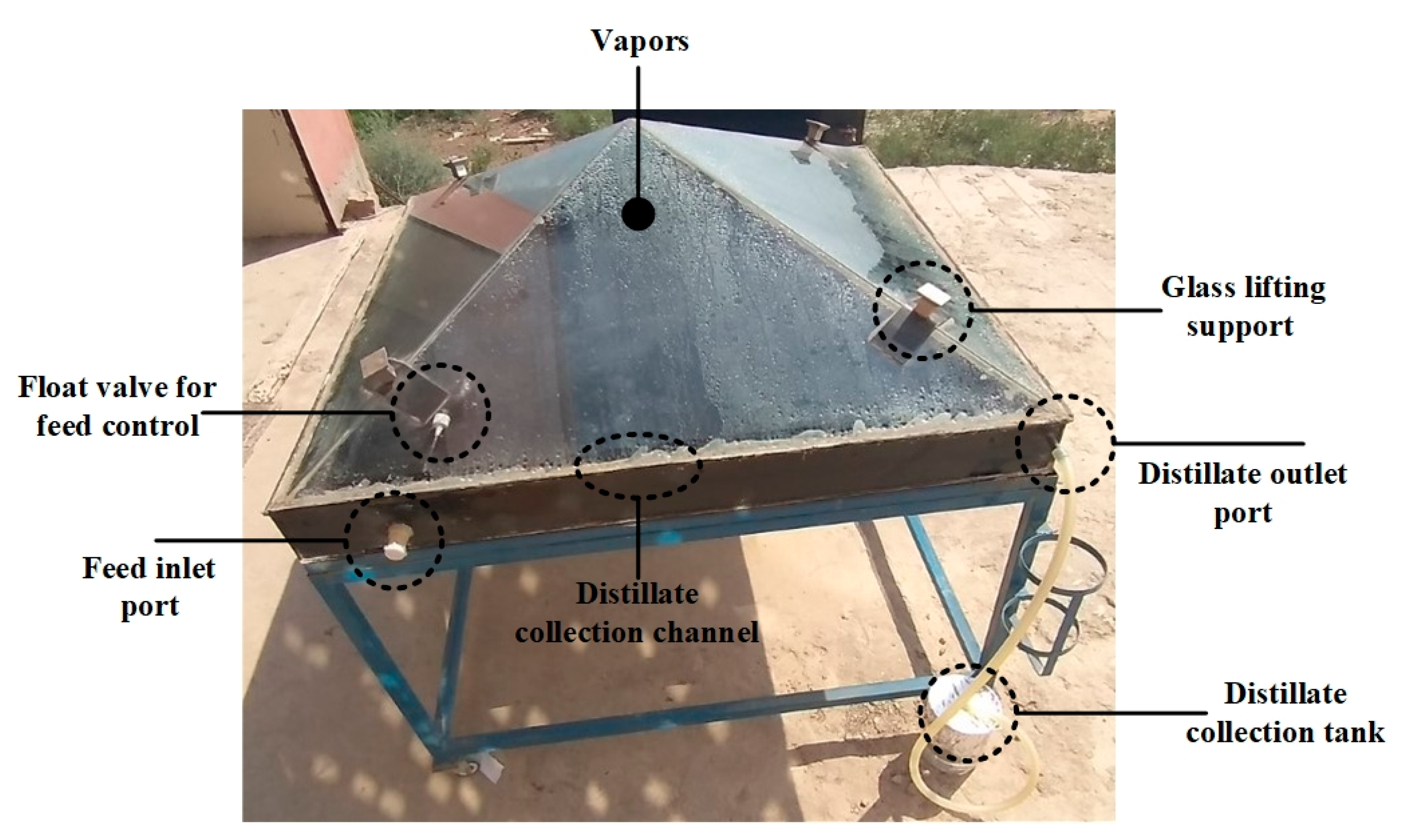
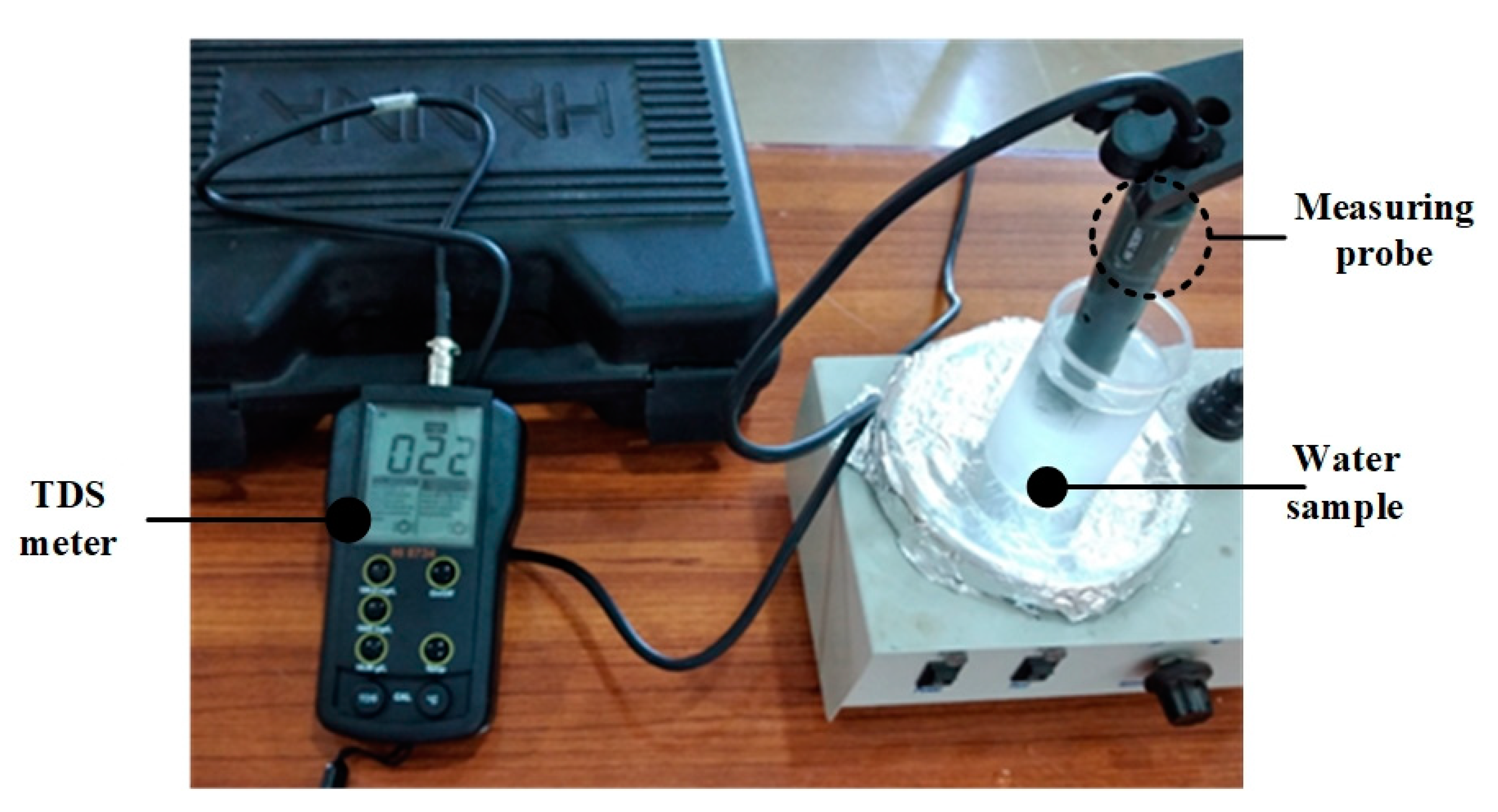
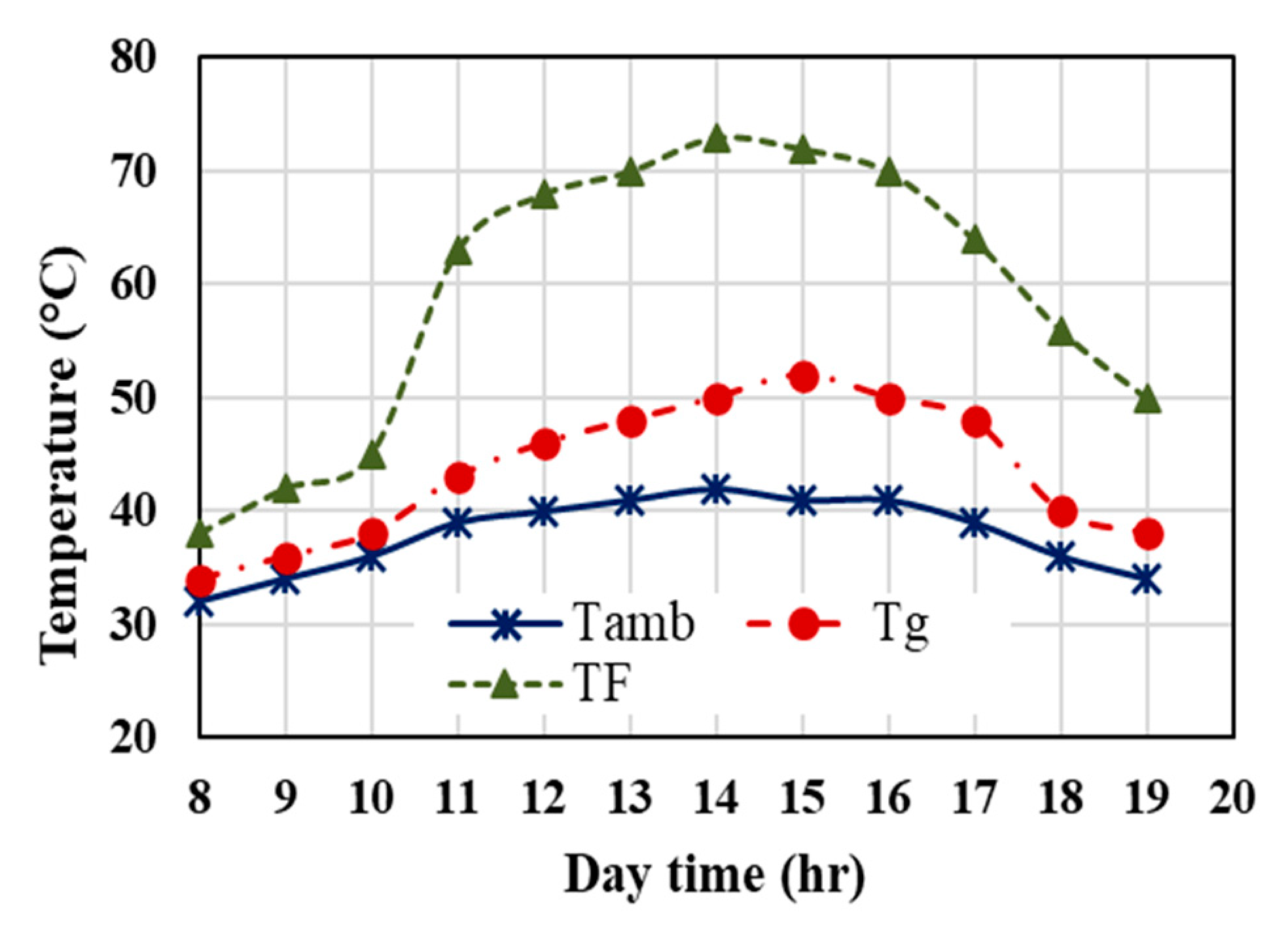
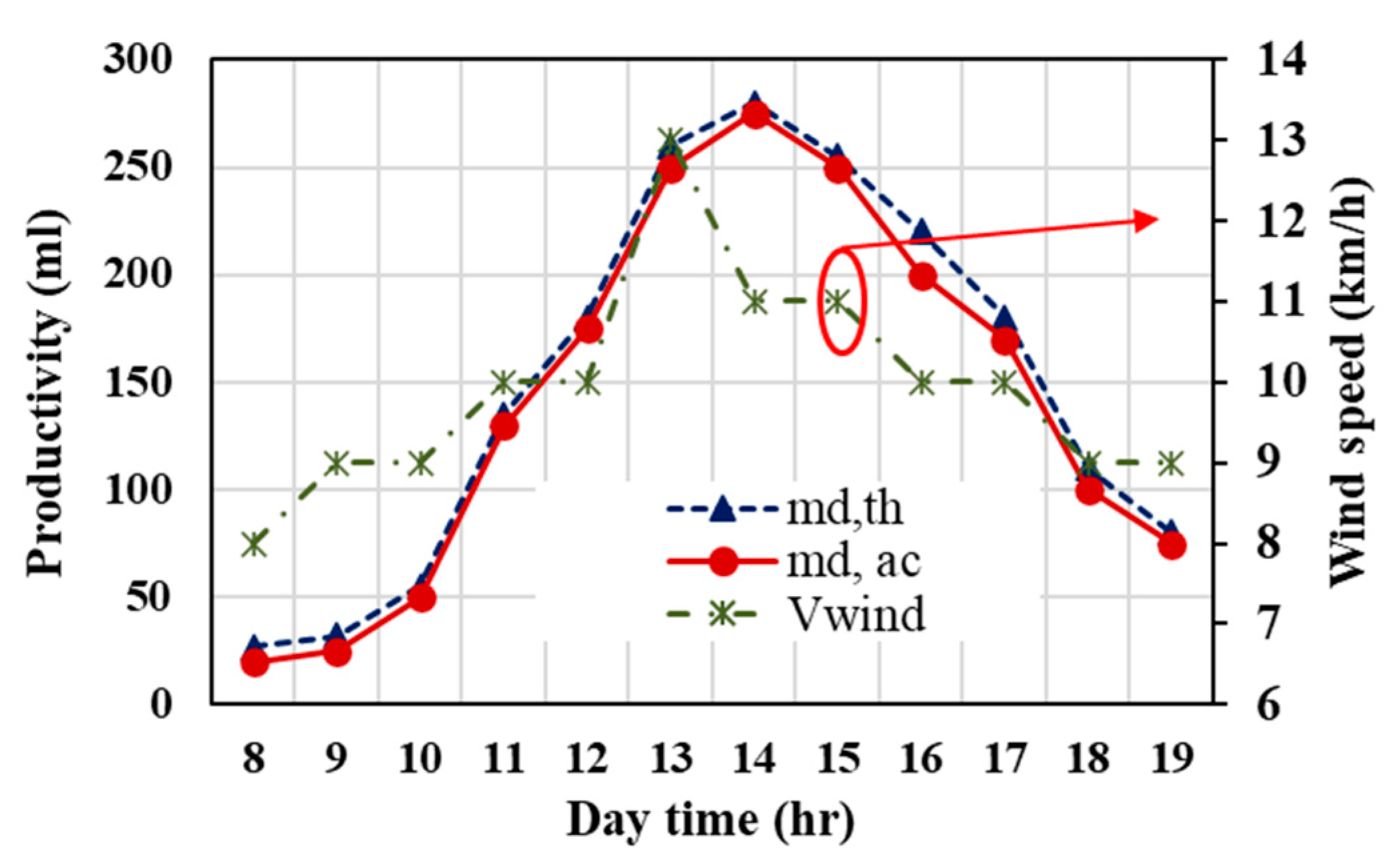

| Parameter | Value |
|---|---|
| Feedwater volume, liters | 17 |
| Total freshwater collected (after 6 days), liters | 15 |
| Rejected brine volume, liters | 1.5 |
| Water lost in handling, liters | 0.5 |
| Feedwater salinity, ppm | 3000 |
| Freshwater salinity, ppm | 22 |
| Brine water salinity, ppm | 33,000 |
| Average potable water, liter/day | 2.5 |
| Time (h) | Tamb (°C) | Tg (°C | Tw (°C) | VWind (km/h) | md,ac (mL/h) |
|---|---|---|---|---|---|
| 7:00–8:00 | 32 | 34 | 38 | 8 | 20 |
| 8:00–9:00 | 34 | 36 | 42 | 9 | 25 |
| 9:00–10:00 | 36 | 38 | 45 | 9 | 50 |
| 10:00–11:00 | 39 | 43 | 63 | 10 | 130 |
| 11:00–12:00 | 40 | 46 | 68 | 10 | 175 |
| 12:00–13:00 | 41 | 48 | 70 | 13 | 250 |
| 13:00–14:00 | 42 | 50 | 73 | 11 | 275 |
| 14:00–15:00 | 41 | 52 | 72 | 11 | 250 |
| 15:00–16:00 | 41 | 50 | 70 | 10 | 200 |
| 16:00–17:00 | 39 | 48 | 64 | 10 | 170 |
| 17:00–18:00 | 36 | 40 | 56 | 9 | 100 |
| 18:00–19:00 | 34 | 38 | 50 | 9 | 75 |
| Water Quality Parameter | Feed Sample | Distillate Sample | Range |
|---|---|---|---|
| Arsenic (μg/L) | NIL | NIL | 10 (WHO) |
| Conductivity (μS/cm) | 2230 | 55 | 2000 (CPCB) |
| TDS (ppm) | 1450 | 22 | 1000 (WHO) |
| pH | 7.3 | 6.5 | 6.5–8.5 |
| Carbonates (mg/L) | NIL | NIL | NGVS |
| Carbonates (mg/L) | 500 | 12 | 300 (mg/L) |
| Chlorides (mg/L) | 344 | 07 | 250 (WHO) |
| Sulphate (mg/L) | 211 | 07 | 250 (WHO) |
| Hardness (mg/L) | 630 | 20 | 500 (WHO) |
| Calcium (mg/L) | 96 | 04 | 100 (KSA) |
| Magnesim (mg/L) | 94 | 02 | 150 (WHO) |
| Sodium (mg/L) | 219 | 03 | 200 (WHO) |
Publisher’s Note: MDPI stays neutral with regard to jurisdictional claims in published maps and institutional affiliations. |
© 2021 by the authors. Licensee MDPI, Basel, Switzerland. This article is an open access article distributed under the terms and conditions of the Creative Commons Attribution (CC BY) license (https://creativecommons.org/licenses/by/4.0/).
Share and Cite
Jamil, M.A.; Yaqoob, H.; Farooq, M.U.; Teoh, Y.H.; Xu, B.B.; Mahkamov, K.; Sultan, M.; Ng, K.C.; Shahzad, M.W. Experimental Investigations of a Solar Water Treatment System for Remote Desert Areas of Pakistan. Water 2021, 13, 1070. https://doi.org/10.3390/w13081070
Jamil MA, Yaqoob H, Farooq MU, Teoh YH, Xu BB, Mahkamov K, Sultan M, Ng KC, Shahzad MW. Experimental Investigations of a Solar Water Treatment System for Remote Desert Areas of Pakistan. Water. 2021; 13(8):1070. https://doi.org/10.3390/w13081070
Chicago/Turabian StyleJamil, Muhammad Ahmad, Haseeb Yaqoob, Muhammad Umar Farooq, Yew Heng Teoh, Ben Bin Xu, Khamid Mahkamov, Muhammad Sultan, Kim Choon Ng, and Muhammad Wakil Shahzad. 2021. "Experimental Investigations of a Solar Water Treatment System for Remote Desert Areas of Pakistan" Water 13, no. 8: 1070. https://doi.org/10.3390/w13081070











